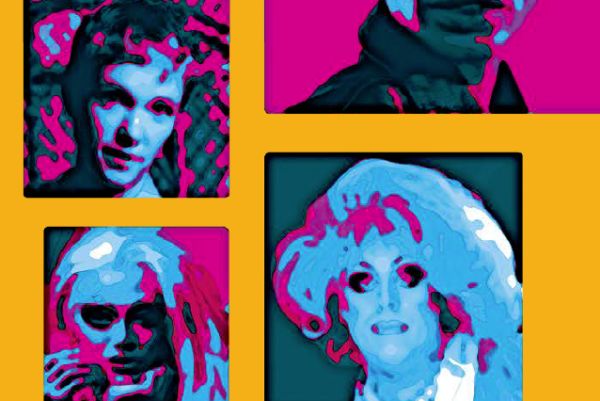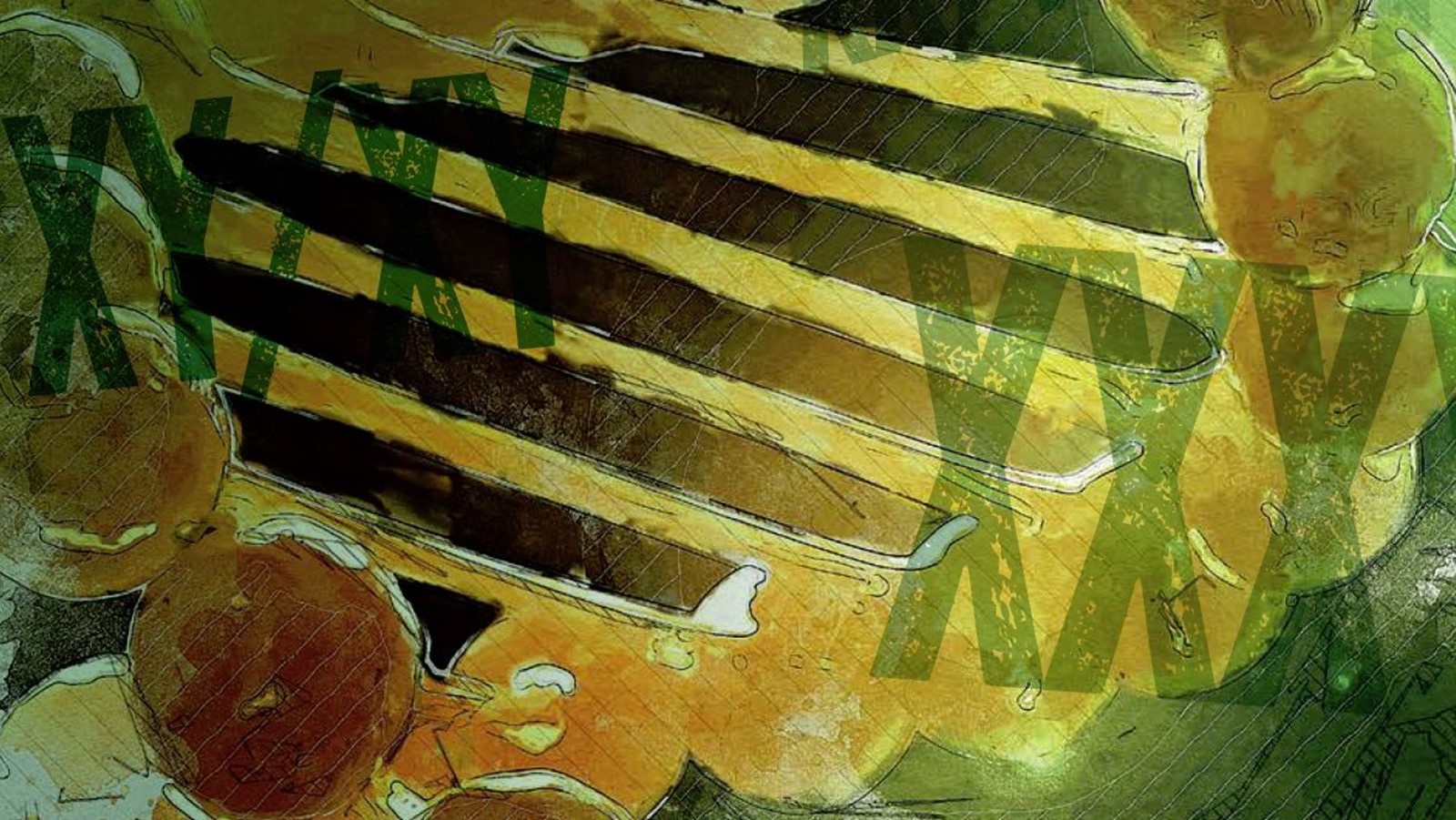Seven (formerly Sarah), who uses the pronouns they/their/them, first sought counselling in their mid-20s, a therapeutic journey that continues today, 16 years on. It was around this time they also learned doctors had performed a gonadectomy (the removal of internal gonads) after misinforming both Seven – then aged eight – and their parents, telling them they were removing Seven’s ‘ovaries’ to prevent cancer.
Seven believes the sexual abuse they subsequently experienced after the operation is connected to the vulnerability they felt having been forced to undergo surgery, leaving them feeling ‘completely alienated from everybody at school’. Seven believes ‘nobody understands’ what it’s like to be intersex and have their gonads or genitals surgically removed or altered as a child, and this belief has presented difficulties in some therapy settings where they have felt they might never truly be seen or accepted by a counselling clinician.
Eden also tearfully describes her experiences at the hands of medical staff, feeling as if her body had been ‘robbed’, being ‘touched inappropriately’ by doctors, and of being ‘sexually abused’ by her father as a child. Although raised as a boy, she remembers thinking, ‘When I hit puberty, I’ll get my vagina back’, and when that didn’t happen, after trying ‘violent ways to kill myself’, she later elected to transition with a genital reconstruction that ‘went horribly wrong’.
Both Seven and Eden are research participants who generously shared their stories for my master’s thesis in integrative psychotherapy, which examines the experiences in therapy of five clients who were born with intersex characteristics. This qualitative study, using the interpretative phenomenological analysis method, found that almost all therapists seen by the co-participants knew nothing about intersex lives and experiences. Reassuringly, this fact notwithstanding, most participants found therapy helpful. One client, Del, reported working with a therapist who, despite not being heterosexual, held a ‘binary’ understanding of gender, and this made the empathic exploration of Del’s body impossible, causing the repeated reproduction of damaging relational dynamics or, to use psychodynamic terminology, enactments.
Intersex
Personal resonances: my mother, now 75 years old, lost her intersex twin sibling, Paul, when a doctor wrapped him in a blanket and placed him alone and crying in a room, where he was left to die. It’s my belief that he was murdered because of his atypical genitalia. My mother says that when she talks about him, she still feels Paul on the arm against which he lay for nine months when they shared their mother’s womb.
His death, by the hand of a medical clinician, and the resultant trauma experienced by my mother, my grandmother and wider family, influences my belief in the need for recognition and ethical treatment of people born with intersex characteristics. The intermingling of personal and professional narratives drove my decision to write my master’s paper on the experience of intersex clients in therapy. This ethical positioning is also informed by what psychologist Katrina Roen refers to as ‘feminist and queer theorizing that challenges claims about gender as fixed and knowable’.1
So, before I address some key points about working with intersex clients and their families, let’s look at the term intersex, and consider why this client group is so invisible. Intersex is an umbrella term that relates to biological sex characteristics. It’s used by clinicians and others to refer to developmental anomalies: genitals, hormones, gonads and/or chromosome patterns that don’t fit typical binary definitions of male or female. Intersex activists describe it as a term applied to human beings ‘whose biological sex cannot be classified as clearly male or female’.2
Some examples of the kinds of anomalies present among those in the intersex population may include: being born with a clitoris that’s larger than expected (clitoromegaly), or in the case of those diagnosed with Androgen Insensitivity Syndrome (AIS), the new-born AIS infant has genitals of female appearance, undescended or partially descended testes, and usually a short vagina with no cervix. Occasionally, the vagina is nearly absent.
At the onset of puberty, intersex individuals may start to develop secondary sex characteristics typically considered to belong to the ‘opposite sex’. For instance, those born with Klinefelter Syndrome (KS) will usually be sterile. At puberty, blood testosterone levels in men with KS are normal initially but may fail to rise into the expected adult range from age 14 onwards.
Intersex status is distinct from a person’s sexual orientation or gender identity. An intersex person may be straight, gay, lesbian, bisexual or asexual, and may identify as female, male, both or neither. It’s worth noting that some intersex people also identify as trans and some don’t. Adding insult to injury – at least as far as most intersex activists are concerned – is the use of the term ‘Disorder of Sex Development’ (DSD), which emerged from debate and the subsequent creation of a Consensus Statement after a convention in Chicago in 2005, where it was agreed that the term would replace ‘intersex’ and ‘hermaphrodite’ in medical literature. The term is controversial because of the implication that what is naturally occurring is considered a ‘disorder’ and so reinforces discourses of pathology and non-normativity for intersex people.
Since 2013, genital surgery performed on intersex babies has been described as a human rights violation, and the utilisation of psychosocial justifications for normalising surgery is now contested. In the UK, there are no laws to protect infants diagnosed with DSD (intersex conditions) from undergoing surgery, which seeks to assign a sex category. A fact sheet about intersex people, produced by the United Nations for LGBT Equality, states: ‘Intersex persons are often subjected to discrimination and abuse if it becomes known that they are intersex, or if they are perceived not to conform to gender norms.’3 They are often subjected to discrimination because those working in public and private healthcare provision frequently lack the training or knowledge to give appropriate care and respect the autonomy and rights of intersex persons to physical integrity and health. These occurrences of discrimination aren’t helped by existing anti-discrimination laws, which don’t protect them.
Statistics
Current statistics suggest that there is a significant UK population of approximately 358,105 people with intersex variations.4 This isn’t reflected in the therapeutic landscape, with few therapists acknowledging or knowledgeable about this client group, nor explicitly identifying as intersex. Furthermore, this client group isn’t visible in therapeutic literature or included on counselling and psychotherapy training curricula.
According to intersex rights campaigners, annually around one in 2,000 live births have intersex characteristics, and one in 200 of these babies are born with visibly variant genitalia which don’t fit typical binary definitions of male or female.5 The true figure is hard to ascertain since most people born with intersex characteristics don’t have variant external anatomies. Of those born with intersex characteristics, some infants will be identified at birth, some may be identified in childhood, some in adolescence, and some much later in life, although some never are.
The reason this client group has until relatively recently remained hidden is largely the result of the medical protocol developed by psychologist John Money in the 1950s, whose theories about hermaphrodites (a term used by clinicians at the time, but now no longer used) are still used as the basis for current treatment practices. Roen explains that Money and colleagues proposed that the sexual reassignment of atypically sexed children would be possible if carried out before a critical age, and if the child was raised unambiguously within the gender role consistent with their new sex.6 Referring to ‘female hermaphrodites’, Money also insisted on lifelong post-surgical secrecy. This protocol was followed in mainstream Western nations where those who fall outside of ‘male’ or ‘female’ aren’t recognised as valid and instead undergo treatment(s) which ‘render[s] intersexuality invisible and maintains it as shameful: something that needs to be hidden or erased’.6 These historical contexts produce the currently accepted conditions for intersex erasure.
Why intersex people may seek therapy
My research data showed that three out of five participants sought therapy initially for issues arising from the knowledge that they had intersex characteristics. The remaining two accessed therapy for reasons connected to, but not initially arising from, their intersex variation. This suggests that counselling support sought by intersex clients is both implicitly and explicitly connected with the trauma of being intersex in a world that fails to recognise their existence, and simultaneously pathologises their very being.
A key finding in the research data further confirms the failure of the standard medical protocol: no participant fully identified with the sex category assigned to them at birth. What’s more, because surgeries are conducted without the child’s consent, they cause ‘severe mental suffering’.7 The ‘heteronormative assumptions’ – that is, the privileging of cisgender and heterosexual presentations ‘underpinning a number of intersex-related medical interventions’8 – have also been called into question.
In a pilot study of psychological distress caused by both the medical management received and the stigma that’s projected onto intersex bodies, Schuetzman et al note that ‘adults with DSD are markedly psychologically distressed, with rates of suicidal tendencies and self-harming behaviour on a level comparable to non-DSD women with a history of physical or sexual abuse’.9 The impact of cumulative harmful surgical experiences, as detailed by participants, is likely to impinge upon intersex people’s sense of their right to exist and their embodiment. A corollary of this non-consensual surgical intervention is noted by Leidolf, who observes that, without informed knowledge and consent, the potential for further abuse is greatly increased, with intersex children made more vulnerable to being victimised by sexual predators.10
Gender identity in therapy with intersex clients
In psychoanalytic work with this client group, the focus in the literature is on gender identity. Indeed psychotherapists in this field, and I suspect across a wider range of therapeutic modalities, have attempted to establish a ‘true sex’ and a ‘stable’ normative gender identity and sexuality with their intersex clients. Practitioners who aren’t intersex themselves are advised to be reflexive about their own relationship with their gendered physiologies before intervening in the lives of others.
While there is certainly a place for exploration of gender identity when working with some in this client group, there are other important areas to consider, such as embodiment, surgery-related trauma and bodily autonomy. In the literature, Harper et al state: ‘…affirmation of the client’s identity and lived experience’ is an important basic therapeutic competency.11 A key finding in my research supported this, showing that when therapy worked for the clients, it was because the therapist had created an environment where non-judgmental self-exploration felt possible, and which allowed one participant, Jo, ‘to be more open’.
Some knowledge of intersex experiences is crucial when working with this client group and their families. Research shows that when the therapist uses their intersex clients to make themselves more knowledgeable, there’s a danger of re-traumatisation, as further exemplified by Seven, who said they found the experience of being ‘positioned as the expert’ by therapists regarding intersex issues problematic, adding that this contributed to a feeling of ‘disconnect’ between them.
Lack of therapist knowledge meant that clients felt it wasn’t possible to work at depth on issues directly relating to their being intersex. Eden suggests that this lack of knowledge on the part of the therapist was a barrier to deeper exploration of what it was like for her to be intersex and transgender. That said, Jo did feel her therapist gave her the space to explore what it means to have an atypical body. Jo also recalls taking on the label of ‘intersex’ as a political as well as medical category only when she had begun to make contact with other political activists and developed a sense of community. The explicit permission to discuss being intersex given by a therapist helped Del to ‘feel better’ about being intersex: ‘I didn’t feel like being intersex was an issue and he didn’t have a problem.’
Vicarious therapist trauma
While researching and writing my study, I was reflexive about the impact of being the adult daughter of a woman who survived the murder of her intersex twin. It’s impossible to know how my own familial intergenerational trauma and the deep sorrow I felt interwove with the stories of trauma and injustice I heard while researching intersex people’s lives. I found nothing in the literature that explored the potential and/or actual trauma experienced by psychotherapists working alongside this highly stigmatised, marginalised and oppressed group of people. There is, nonetheless, research on secondary traumatic stress.12 My own responses, and that of a participant’s therapist who ‘cried several times’ during their work together, suggests this is a phenomenon that therapists will need to consider.
Further, it’s my belief that some clinicians are so psychologically invested in their own normative physiologies, and so challenged by bodies that violate normative rules, that they switch off from the trauma they experience at the thought of not having normative bodies. This denial and dissociation is then reproduced at an institutional level through the treatment protocols that enforce a binary gender on all people. This corporeal anxiety additionally suggests that the shame projected into intersex bodies and the conspiracy of silence13 that’s so often reproduced between clinicians, parents, and their intersex children can be replicated in the therapy room when intersex awareness isn’t made explicit, either verbally by the therapist or in their promotional material.
It’s this pervasive shame and silence about intersex lives that I believe underpins Seven’s comment about feeling as if they were ‘less-than human’, compared with their therapists. Similarly, Jo mentioned that it wasn’t until she became aware of intersex activism, several years after she first started therapy, that she felt her intersex body and sense of identity were legitimate subjects for therapy, despite having spent years trying to hide her facial hair.
Finally, Suchet notes that ‘embodiment is not a given, but a complex process of acquiring a sense of ownership of one’s material flesh, an investment in the bodily self’, and understands that while it is ‘influenced by physiological, cultural and unconscious process’, it is also ‘highly sensitive to traumatic disruption’,14 as evidenced in the stories of all five co-participants. As intersubjectivity is an embodied process15 it’s important that practitioners think about how this work will affect their own sense of embodiment, in addition to embracing research on the social construction of sex, gender and biology. Science historian, Alice Dreger, author of Hermaphrodites and the Medical Invention of Sex, believes ‘the way we choose to categorise and delineate males and females (and others) is basically a social decision… a decision some would call a social construction’.16
The main conclusions arising from my research showed that the bodily integrity and autonomy of intersex people have been severely and repeatedly compromised through institutional treatment practices and through the imposition of normative binary sex and gender categories, and it’s therefore vital that adequate therapy is provided. This impinged-upon bodily integrity also has a wider impact on the lovers, partners, families and friends of intersex people. That said, there’s significant mistrust of therapists and clinicians in general, so it’s strongly recommended that therapists educate themselves on non-normative gender identities and bodies, as well as in regard to treatment protocols and associated legal, sociopolitical and cultural impingements imposed upon this client group.
The last word goes to Seven, who advises the following to therapists working with intersex clients: ‘No matter how great a therapist you are, you are probably going to be rejected, you are probably going to experience anger, you are probably going to experience a lot of negative emotional states, so you really need to be grounded and you really need not to personalise that stuff.’
Jane Czyzselska is an integrative relational psychotherapist working in London. Having worked for over 20 years as a journalist, during which time she was editor of DIVA magazine from 2004–2017, she is committed to amplifying lesbian, bi, queer, non-binary, trans and intersex voices. She works with a diverse range of heterosexual and LGBTQI clients and writes for a range of queer and non-queer publications. With intersex activist and academic Valentino Vecchietti, she is currently devising a workshop for therapists who want to know more about working with intersex clients, and is passionate about knowledge-sharing in the service of providing the best possible therapeutic experiences for this client group.
tinyurl.com/LGBTQItherapy shoreditchtherapy.com
More from Private Practice

Gender mosaic
Open article: If we empower clients who bring the topic of gender identity into the therapy room with an awareness of their psychological process, and help them to become emotionally robust, they will make healthy choices, writes Michelle Bridgman. Private Practice, Winter 2017

Relationships: Family affair
Open article: A personal reflection on my and my family’s relationship with both the process and the business of counselling. Private Practice, Autumn 2017

They think it’s Alzheimer’s
Open article: When her mum was diagnosed with Alzheimer’s, Trudi Dargan already knew at some level that the memory lapses and confusion she’d been experiencing were more than the usual ones that come with ageing. Private Practice, Summer 2017
References
1. Roen K. ‘But we have to do something’: surgical ‘correction’ of atypical genitalia. Body Society 2008; 14: 47–66.
2. OII-UK Intersex in the UK. [Online.] http://oiiuk.org/ (accessed 3 February 2018).
3. United Nations for LGBT Equality. Fact sheet: intersex. [Online.] https://unfe.org/system/unfe-65-Intersex_Factsheet_ENGLISH.pdf (accessed 3 February 2018).
4. Czyzselska J. Invisible communities: hidden realities of intersex people in therapy, and sensitive ways of working with this client group; an interpretative phenomenological analysis. Unpublished MA dissertation; 2016.
5. OII Australia. [Online.] http://oii.org.au/ (accessed in 2016).
6. Roen K. Intersex embodiment: when health care means maintaining binary sexes. Sexual Health 2004; 1(3): 127–130.
7. Mendez J. Report of the Special Rapporteur on torture and other cruel, inhuman or degrading treatment or punishment. Promotion and protection of all human rights, civil, political, economic, social and cultural rights, including the right to development. UN HRC; 013. [Online.] http://www.ohchr.org/Documents/HRBodies/HRCouncil/RegularSession/Session22/A.HRC.22.53_English.pdf (accessed 8 October 2016).
8. Liao LM, Roen K. Intersex/DSD post-Chicago: new developments and challenges for psychologists. Psychology & Sexuality 2014; 5(1): 1–4.
9. Schuetzman K, Brinkmann L, Schacht M, Richter-Appelt H. Psychological distress, self-harming behavior and suicidal tendencies in adults with disorders of sex development. Archive of Sex Behaviour 2009; 38: 16–33.
10. Leidolf EM. The missing vagina monologue... and beyond. The Journal of Gay and Lesbian Psychotherapy 2006; 10(2): 77–92.
11. Harper A, Finnerty P, Martinez M, Brace A, Crethar HC, Loos B, Harper B, Graham S, Singh A, Kocet M, Travis L, Lambert S, Burnes T, Dickey LM, Hammer TR. Competencies for counselling with lesbian, gay, bisexual, queer, questioning, intersex and ally Individuals. London: Routledge; 2013.
12. Sanderson C. Introduction to counselling survivors of interpersonal trauma. London: Jessica Kingsley Publishers; 2010.
13. Toal P. Is it a boy or a girl? The lived experience of intersex individuals in Ireland. Dublin: Dublin City University. Unpublished MSc dissertation; 2014.
14. Suchet M. Crossing over. Psychoanalytic Dialogues: The International Journal of Relational Perspectives 2011; 21(2): 172–191.
15. Reis B. We: commentary on papers by Trevarthen, Ammaniti & Trentini, and Gallese. Psychoanalytic Dialogues: The International Journal of Relational Perspectives 2009; 19: 565–579.
16. Dreger AD. Hermaphrodites and the medical invention of sex. Connecticut: Harvard University Press; 2000.
